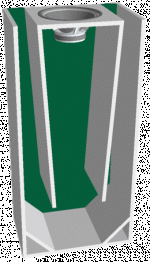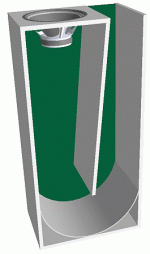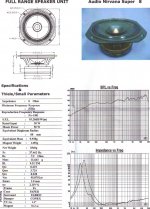Hi, relatively new here.
I was recently given a pair of Audio Nirvana super 8" drivers from a friend
Attached are the driver specifications, so nobody has to search for that...
I'm interested in building a folded transmission line style enclosure out of concrete. The drivers themselves seem to be lacking a bit in the bass department. surprise surprise.
I've come across a few threads already within DIY audio community as well as on the internet in relation to the topic...
Austrians build concrete cast 5.1 speaker set
http://www.diyaudio.com/forums/multi-way/129734-concrete-horns.html
Concrete Speaker Build Photos by bogey61 | Photobucket
http://www.diyaudio.com/forums/full-range/196160-chp70-concrete-build.html
I'm considering designing the speaker box similar to the two attached images. Although I would like to make the walls cylindrical in cross section (more true to horn shape) as well as outer physical appearance.
wondering if there is any significant dis/advantage to having two openings as opposed to one?
Construction is not so much of an issue for me. Skilled in woodworking, metal fabrication, mold-making, casting etc. I am new, however to speaker box design (the physics side of things)
It seems many people have decided on a rear loaded horn system to enhance their FR drivers. I'm worried about size, however, some enclosures i've seen are absolutely massive! Especially considering my desire to use concrete. Am I totally wrong in assuming that a quarter wave enclosure would be smaller?
Would adding light weight aggregates to the concrete interfere with sound quality?
Can anyone point me in the direction of additional related resources?
Any help would be much appreciated!!!
I was recently given a pair of Audio Nirvana super 8" drivers from a friend
Attached are the driver specifications, so nobody has to search for that...
I'm interested in building a folded transmission line style enclosure out of concrete. The drivers themselves seem to be lacking a bit in the bass department. surprise surprise.
I've come across a few threads already within DIY audio community as well as on the internet in relation to the topic...
Austrians build concrete cast 5.1 speaker set
http://www.diyaudio.com/forums/multi-way/129734-concrete-horns.html
Concrete Speaker Build Photos by bogey61 | Photobucket
http://www.diyaudio.com/forums/full-range/196160-chp70-concrete-build.html
I'm considering designing the speaker box similar to the two attached images. Although I would like to make the walls cylindrical in cross section (more true to horn shape) as well as outer physical appearance.
wondering if there is any significant dis/advantage to having two openings as opposed to one?
Construction is not so much of an issue for me. Skilled in woodworking, metal fabrication, mold-making, casting etc. I am new, however to speaker box design (the physics side of things)
It seems many people have decided on a rear loaded horn system to enhance their FR drivers. I'm worried about size, however, some enclosures i've seen are absolutely massive! Especially considering my desire to use concrete. Am I totally wrong in assuming that a quarter wave enclosure would be smaller?
Would adding light weight aggregates to the concrete interfere with sound quality?
Can anyone point me in the direction of additional related resources?
Any help would be much appreciated!!!
Attachments
How did you design these rear loaded horns? If you are not using a known design and doing your very own horn design, it would be good to model or simulate it with many of the available programs out there.Hornresp is probably the easiest to use and is free. AkaBak and Martin J King's Mathcad worksheets are another option. Then before you 'pour any concrete' build a prototype to check the aeroacoustic behavior of the horn design first. The prototype can be quickly made using foam core board (see foam core thread). This lets you check and listen to sound produced due to the resonant structure geometry that you designed. Once you find a prototype that does what you want, and hopefully it sounds good, build it in concrete or whatever more permanent structure of your choice. The sound from a foam core structure will be different as it transmits sound compared to concrete, but this effect will be minor compared to the major acoustical modes that you are trying to use in the rear loaded horn to augment the bass. The bass will really only depend on the geometry not the material of construction. Btw, the enclosures you show are more like transmission lines rather than horns. But the software can model them nonetheless. If you are really new at this, I recommend building a design someone else has already tested with your particular driver.
Good luck.
Good luck.
Alas, if you want LF output from the AN Super 8, a TL enclosure isn't a great choice given its low Q. With suitable Eq, you could force it to produce LF output, but dynamic range will suffer. A resonant pipe would do OK, but you'd almost certainly need some expansion to get sufficient gain over a broad enough BW. It does need a reasonably large box if you want to take it low, with decent output. Pick any two of the following; the laws of physics dictate you can't have all three: small size, low bass, high efficiency.
This may be of interest regarding concrete enclosures
https://sites.google.com/site/matteisloudspeakers/home/the-matteis-story
The writer came to the conclusion that the baffle was the bit he thought necessary to manufacture from concrete, rather than the whole enclosure.
https://sites.google.com/site/matteisloudspeakers/home/the-matteis-story
The writer came to the conclusion that the baffle was the bit he thought necessary to manufacture from concrete, rather than the whole enclosure.
for best results using that driver (all an8), don't try and get them to go low. if possible try and use them with something that does the low end for them. with a fairly small and simple enclosure you can get them to cross to sub's or woofers at around 80-100hz which for me sounded a world better than trying to use them with Horn/standing wave type enclosures.
they weren't 'bad' as such when in those enclosures, they just required extra help with the EQ etc which i felt defeated the object somewhat (clipping or reducing DB's whichever way you used it). as soon as i freed them from performing past their 'natural' ability, they tended to change in character for me. the accuracy and presentation of their sound is better, their ability to express percussion and basic fundamental frequency of instruments just sounded more accurate and less strained than when they were also being hammered with frequencies extending into the 40's of hz.
they weren't 'bad' as such when in those enclosures, they just required extra help with the EQ etc which i felt defeated the object somewhat (clipping or reducing DB's whichever way you used it). as soon as i freed them from performing past their 'natural' ability, they tended to change in character for me. the accuracy and presentation of their sound is better, their ability to express percussion and basic fundamental frequency of instruments just sounded more accurate and less strained than when they were also being hammered with frequencies extending into the 40's of hz.
How did you design these rear loaded horns? ... Btw, the enclosures you show are more like transmission lines rather than horns.
The 2 3D visualizations are ones i did over a decade ago, from here: AQA Bass Box
dave
- Status
- This old topic is closed. If you want to reopen this topic, contact a moderator using the "Report Post" button.
- Home
- Loudspeakers
- Full Range
- transmission line enclosure (concrete?)


